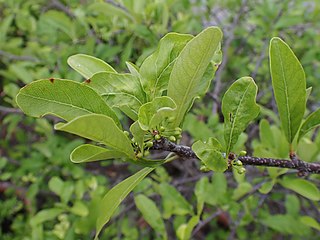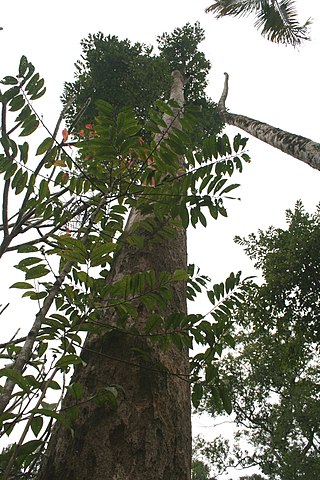
|} Meliaceae, the mahogany family, is a flowering plant family of mostly trees and shrubs in the order Sapindales.

Cedrela is a genus of several species in the mahogany family, Meliaceae. They are evergreen or dry-season deciduous trees with pinnate leaves, native to the tropical and subtropical New World, from southern Mexico south to northern Argentina.

The Sapotaceae are a family of flowering plants belonging to the order Ericales. The family includes about 800 species of evergreen trees and shrubs in around 65 genera. Their distribution is pantropical.

Chrysophyllum is a group of trees in the Sapotaceae described as a genus by Linnaeus in 1753.

Manilkara is a genus of trees in the family Sapotaceae. They are widespread in tropical and semitropical locations, in Africa, Madagascar, Asia, Australia, and Latin America, as well as various islands in the Pacific and in the Caribbean. A close relative is the genus Pouteria.
Celianella is a genus of plants belonging to the family Phyllanthaceae first described in 1965. It has only one known species, Celianella montana, native to Guyana and to southern Venezuela. It is dioecious, with male and female flowers on separate plants.

Guarea is a genus of evergreen trees or shrubs in the family Meliaceae, native to tropical Africa and Central and South America. At their largest, they are large trees 20–45 m tall, with a trunk over 1 m diameter, often buttressed at the base. The leaves are pinnate, with 4–6 pairs of leaflets, the terminal leaflet present. They are dioecious, with male and female flowers on separate plants. The flowers are produced in loose inflorescences, each flower small, with 4–5 yellowish petals. The fruit is a four or five-valved capsule, containing several seeds, each surrounded by a yellow-orange fleshy aril; the seeds are dispersed by hornbills and monkeys which eat the aril.

Pouteria is a genus of flowering trees in the gutta-percha family, Sapotaceae. The genus is widespread throughout the tropical Americas, with outlier species in Cameroon and Malesia. It includes the canistel, the mamey sapote, and the lucuma. Commonly, this genus is known as pouteria trees, or in some cases, eggfruits.

Francisco Manuel Barroso, Baron of Amazonas was a Brazilian admiral of the Imperial Brazilian Navy.

Sideroxylon is a genus of trees in the family Sapotaceae described as a genus by Linnaeus in 1753. They are collectively known as bully trees. The generic name is derived from the Greek words σιδηρος (sideros), meaning "iron", and ξύλον (xylon), meaning "wood."

Oenocarpus is a genus of pinnate-leaved palms (Arecaceae) native to Trinidad, southern Central and tropical South America. With nine species and one natural hybrid, the genus is distributed from Costa Rica and Trinidad in the north to Brazil and Bolivia in the south.

Sideroxylon lanuginosum is a shrub or small tree of the family Sapotaceae. It is native to the Sun Belt and Midwest of the United States as well as Northeastern Mexico. Common names include gum bully, black haw, chittamwood, chittimwood, shittamwood, false buckthorn, gum bumelia, gum elastic, gum woolybucket, woolybucket bumelia, wooly buckthorn, wooly bumelia, ironwood and coma.

Micropholis is group of trees in the family Sapotaceae, described as a genus in 1891.

Madhuca is a genus of plants in the family Sapotaceae first described as a genus in 1791.

Pradosia is a genus of plants in the family Sapotaceae described as a genus in 1872.

Englerophytum is a group of trees in the family Sapotaceae described as a genus in 1914.

Ecclinusa is a genus of plants in the family Sapotaceae described as a genus in 1839.

Elaeoluma is a genus of plants in the family Sapotaceae described as a genus in 1891.
Paul Hermann Wilhelm Taubert was a German botanist.

Cabralea is a genus of trees in the family Meliaceae. It has one species, Cabralea canjerana. It is dioecious, with male and female flowers on separate plants.
















